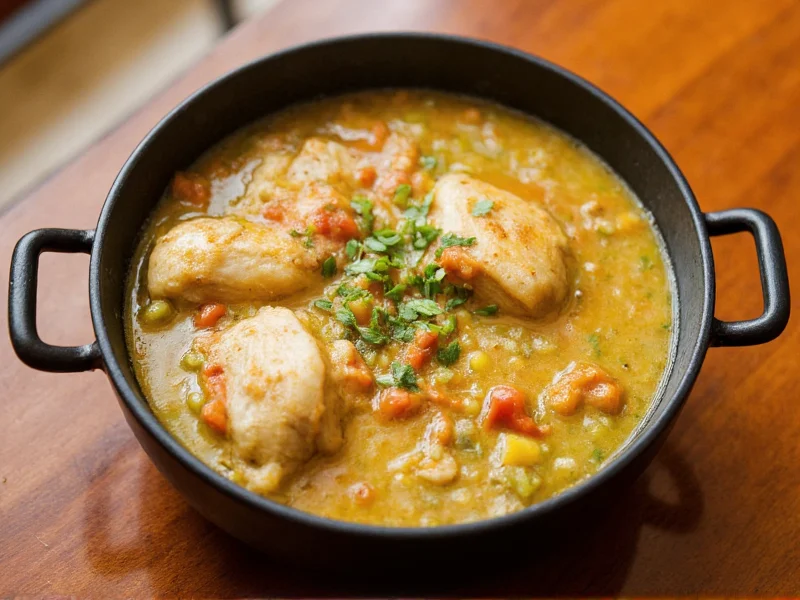When crafting soup with chicken thighs, you're choosing a cut that naturally enhances both texture and taste. The dark meat's fat marbling melts during cooking, enriching the broth with deep poultry flavor while keeping the meat succulent. This makes chicken thigh soup particularly satisfying during colder months and perfect for meal prep due to its freezer-friendly nature.
Why Chicken Thighs Outperform Other Cuts in Soup
Understanding the science behind soup with chicken thighs reveals why this cut deserves starring role in your next batch. Chicken thighs contain approximately 30% more fat than breasts, which serves two critical functions in soup preparation:
- Flavor carrier - Fat dissolves and distributes fat-soluble flavor compounds throughout the broth
- Moisture retention - Prevents the meat from drying out during prolonged simmering
Additionally, thighs contain more collagen in their connective tissues. When heated in liquid, this collagen converts to gelatin, giving your chicken thigh soup recipe that luxurious mouthfeel professional chefs prize. Bone-in thighs contribute even more depth as marrow and minerals leach into the broth.
Essential Ingredients for Perfect Chicken Thigh Soup
The foundation of exceptional chicken thigh soup for cold weather starts with quality components. While variations exist, these core elements create consistently delicious results:
| Ingredient | Quantity | Key Function |
|---|---|---|
| Bone-in chicken thighs | 2 lbs (about 6 pieces) | Provides rich flavor base and tender meat |
| Yellow onions | 1 large, diced | Creates aromatic foundation (mirepoix base) |
| Carrots | 2 medium, sliced | Adds natural sweetness and texture |
| Celery ribs | 2 stalks, chopped | Contributes herbal notes and complexity |
| Garlic cloves | 3, minced | Enhances overall flavor profile |
| Chicken stock | 6 cups low-sodium | Liquid base that concentrates during cooking |
| Fresh thyme | 2 sprigs | Adds earthy aroma without overpowering |
Step-by-Step Preparation Guide
Follow this professional approach for easy chicken thigh soup that delivers restaurant-quality results:
- Prep thighs: Pat bone-in, skin-on thighs dry with paper towels (critical for proper browning)
- Sear properly: Heat 1 tbsp oil in heavy pot over medium-high heat. Brown thighs skin-side down for 5-6 minutes until golden. Flip and cook 3 minutes more. Remove and set aside.
- Build flavor base: In same pot, add onions, carrots, and celery. Cook 8-10 minutes until softened. Add garlic and cook 1 minute more.
- Simmer correctly: Return thighs to pot with any accumulated juices. Add stock and thyme. Bring to gentle simmer (not boil), skimming any foam.
- Cook to perfection: Partially cover and simmer 30-40 minutes until thighs reach 165°F internally. Remove thighs, shred meat, and return to pot.
- Final seasoning: Adjust salt and pepper. For creamy chicken thigh soup, stir in 1/2 cup heavy cream at the end.
Avoiding Common Chicken Thigh Soup Mistakes
Even experienced cooks make these errors when preparing bone-in chicken thigh soup:
- Boiling instead of simmering - Vigorous boiling makes meat tough and creates cloudy broth. Maintain gentle bubbles at surface.
- Overcooking the thighs - Unlike breasts, thighs can handle longer cooking, but 45 minutes is maximum before texture suffers.
- Skipping the sear - Proper browning creates Maillard reaction compounds essential for deep flavor.
- Adding salt too early - Season in stages, with final adjustment after meat is shredded and flavors have melded.
- Discarding the skin - Cooking with skin on protects meat during simmering; remove after cooking if desired.
Variations for Every Preference
Once you've mastered the best soup with chicken thighs foundation, customize with these popular adaptations:
- Mediterranean style: Add lemon zest, olives, and fresh oregano during last 10 minutes of cooking
- Asian-inspired: Substitute ginger for garlic, add soy sauce and rice vinegar, finish with cilantro
- Hearty winter version: Include diced potatoes, parsnips, and a Parmesan rind while simmering
- Low-carb option: Replace starchy vegetables with mushrooms, bok choy, and extra celery
- Spicy kick: Add red pepper flakes with garlic or a dash of hot sauce before serving
Storage and Reheating Guidelines
Your healthy chicken thigh soup improves with time as flavors meld. Follow these storage recommendations:
- Refrigeration: Cool completely within 2 hours. Store in airtight container for up to 4 days.
- Freezing: Portion into freezer-safe containers with 1-inch headspace. Keeps well for 3 months.
- Reheating: Warm gently over medium-low heat without boiling. Add splash of water or stock if too thick.
- Revitalizing leftovers: Stir in fresh herbs or a squeeze of lemon juice to brighten flavors after storage.
Frequently Asked Questions
Can I use boneless chicken thighs for soup?
Yes, boneless thighs work well but require adjustment. Reduce cooking time to 20-25 minutes since they cook faster without bones. For maximum flavor, consider adding a chicken wing or neck to the broth while simmering to compensate for missing bone elements.
Why is my chicken thigh soup greasy?
Excess grease typically comes from not skimming fat during cooking. After browning thighs, remove them and skim visible fat from the pot before adding vegetables. During simmering, periodically remove foam and fat from the surface. Chilling finished soup allows fat to solidify on top for easy removal.
How do I prevent chicken thighs from becoming rubbery in soup?
Rubbery texture occurs when thighs are boiled too vigorously or for too long. Maintain a gentle simmer (small bubbles breaking surface occasionally), not a rolling boil. Remove thighs when they reach 165°F internally (about 35 minutes for bone-in), then shred and return to broth. Overcooking beyond 45 minutes causes texture deterioration.
What vegetables pair best with chicken thighs in soup?
Classic mirepoix (onions, carrots, celery) forms the ideal base. For heartier soup with chicken thighs, add potatoes, parsnips, or turnips. Quick-cooking vegetables like green beans, zucchini, or spinach should be added during the last 5-10 minutes of cooking to maintain texture and color.











 浙公网安备
33010002000092号
浙公网安备
33010002000092号 浙B2-20120091-4
浙B2-20120091-4